John Schoustra’s experience growing plants is broad. Just his current ventures look like this: he operates Greenwood Daylily Gardens alongside his wife, growing and breeding daylillies, irises, and more; he is the Orchard Manager of Apricot Lane Farms, overseeing an array of fruit tree types from figs to peaches to cherimoyas on the “Biggest Little Farm”; and he grows an innovative grove of avocado trees.
Schoustra’s avocado grove in Ventura County was the subject of an interview I did with him for the California Avocado Society’s Quarterly magazine. Apologies for some avocado industry jargon in the interview; in brackets, I define a few terms to help with this. Nonetheless, I think the interview makes for interesting reading for any backyard avocado grower or even any avocado eater.
Greg Alder: Tell us about your grove, its history, and the conditions your avocados grow in.
John Schoustra: We’re in Somis, with distant ocean views. When we bought the ranch it had about 30 acres of Hass on Duke 7 [rootstock], and the trees were 40 to 60 feet tall. They had been planted in 1982. There was root rot, worse in some areas than others.
How was the root rot disease diagnosed?
At first it was just based on the symptoms shown by the trees. Later when we pushed some over we saw their rotten root systems. Then some University of California researchers tested the soil because they were going to do a rootstock trial here and they found Phytophthora cinnamomi throughout. [P. cinnamomi is the microorganism that is said to cause root rot disease in avocado trees.]
How did you manage these conditions that you started with?
I noticed that the trees in the worst condition were in the windiest locations. We’re on a hill about 400 feet higher than anything near us so we have almost no frost pressure, but we have wind. High on the east side of the hill the trees looked the worst. All their leaf duff had been blown away, and into areas that didn’t have root rot.
My first instinct was to add that organic matter back. I had run a composting operation before so I added compost in order to bring more life into the soil. That didn’t help much.
Then I learned from Ben Faber [University of California Cooperative Extension farm advisor] that P. cinnamomi was a “cellulose-based life form,” as I think he called it: not bacteria or fungus. So I started using tree chips which, unlike compost, are raw cellulose. The bacteria and fungi that break down tree chips compete directly with and prey on the P. cinnamomi.
I also met Dr. Elaine Ingham at an event at UCLA. She studies microbial life in the soil. She described P. cinnamomi as “a wimp of the rhizosphere” that can only thrive in a soil that has been stripmined of organic matter and has high salt levels from irrigation and fertilization. Applying tree chips cuts down on the need for irrigation and fertilization. Last year I applied less than 1 acre-foot of water per acre and I haven’t applied any fertilizer or sprays in 15 years.
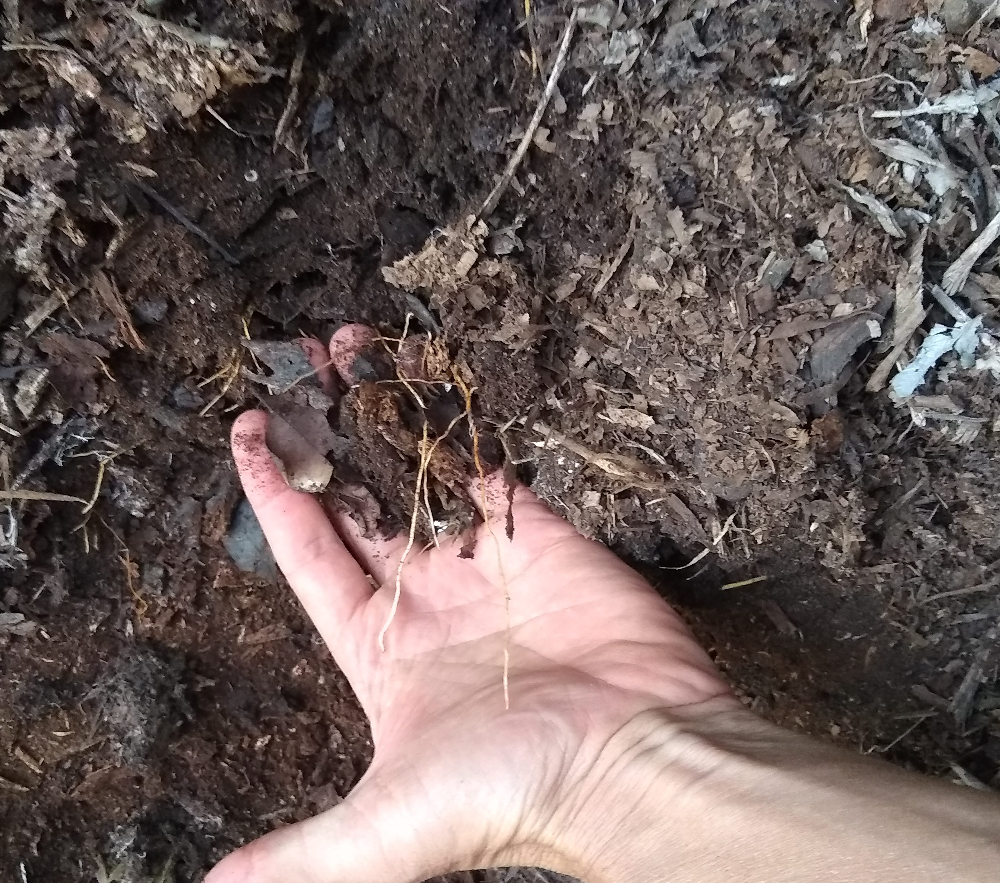
Were you also pruning those big old trees?
I was gently bringing the trees down in size like an arborist would. But a revelation regarding pruning came when I attended a talk by Claudio Hernandez Artaza with Index Fresh, who described how to prune avocados to give them “eternal youth.” He said, “Tell the tree where you want fruit by cutting it there.” If you cut at 15 feet off the ground, the tree’s going to grow back and make fruit between 15 and 20 feet up, where it’s more exposed to the wind, harder to keep hydrated and more work to pick.
Tell me about the concept of “old man” wood.
That’s my simplistic translation of what Claudio was teaching. Cutting back old wood gradually just gets you more tired old wood. Cutting back to within 22 inches of the crown results in vigorous “teenager” growth that is more disease resistant, makes the most flowers and the biggest, easiest to harvest fruit. I started cutting one major limb back to within two feet of the main trunk each year in order to get this teenage wood to grow down there and sure enough: more flowers and bigger fruit, and less ailments too. I try to cut back one “major” every year.
I like this better than stumping [cutting the whole tree back at once] because then you are dealing with a whole tree of teenager growth and that’s too hard to handle.
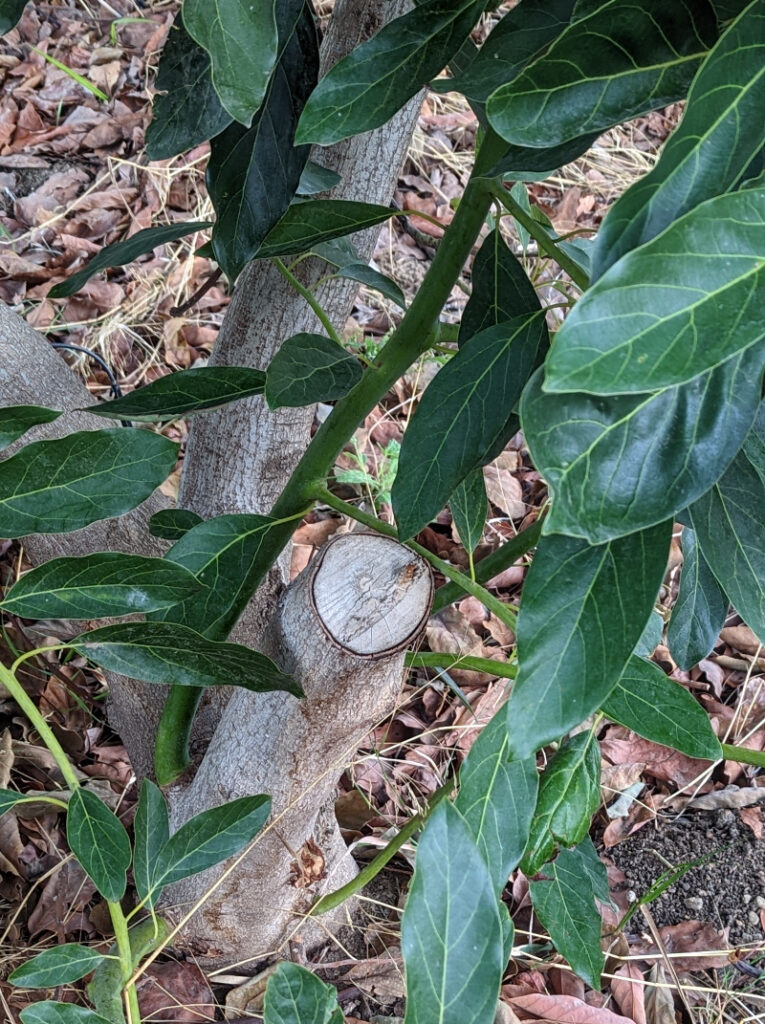
Now you have many new trees planted too. Which did you plant first?
In 2010, we planted three rows of Lamb on Toro Canyon rootstock. I was interested in trying high density [close planting], but made a couple mistakes with that planting.
One was that the trees were planted on contour, running across a steep slope. It’s easy to roll a tractor driving across a slope. Two was that it was hard to access that middle row of trees, to prune or harvest or mulch.
These Lambs are still performing well, but I made changes to the planting design for later sections.
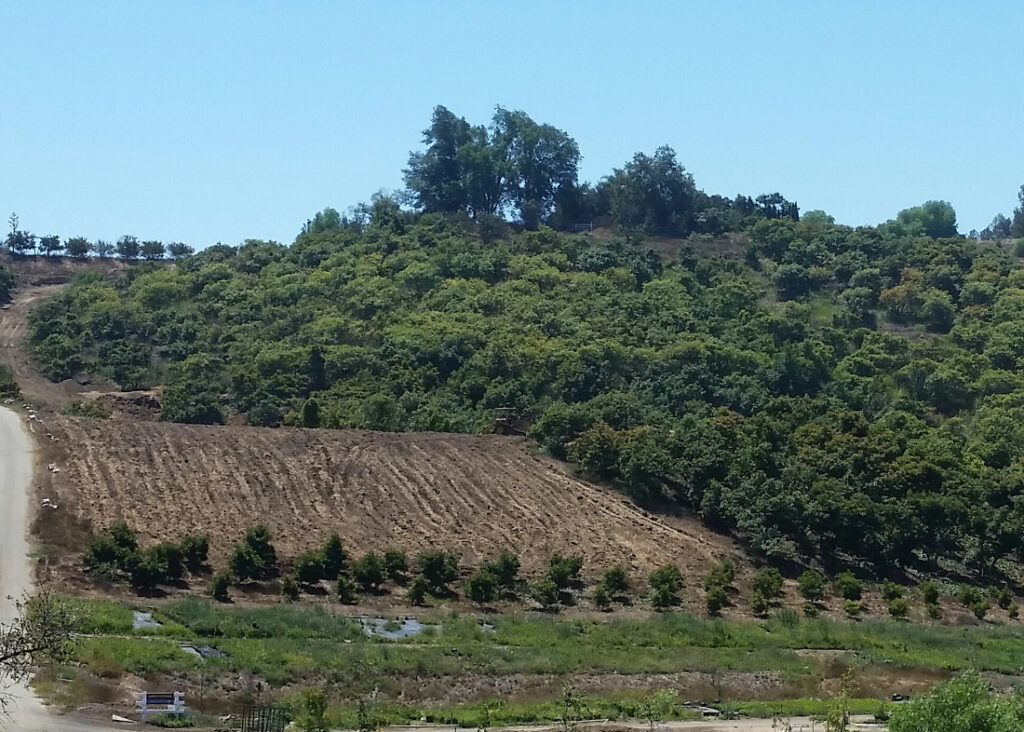
How did you arrange your next planting?
In 2016, we planted Hass on three rootstocks: Toro Canyon, Dusa, and Duke 7. I formed berms 3 feet high and 15 feet wide running straight up and down the slope. The two rows on each berm are 8 feet apart, with trees in each row spaced 12 feet apart. Spacing between the 2 rows is staggered. I sacrificed some trees to widen roads and give tree trimmers a place to dump chips at the top of the rows. This allows me to push the chips down the hill into place with a tractor or Bobcat, which is far easier than moving the chips one bucket at a time.
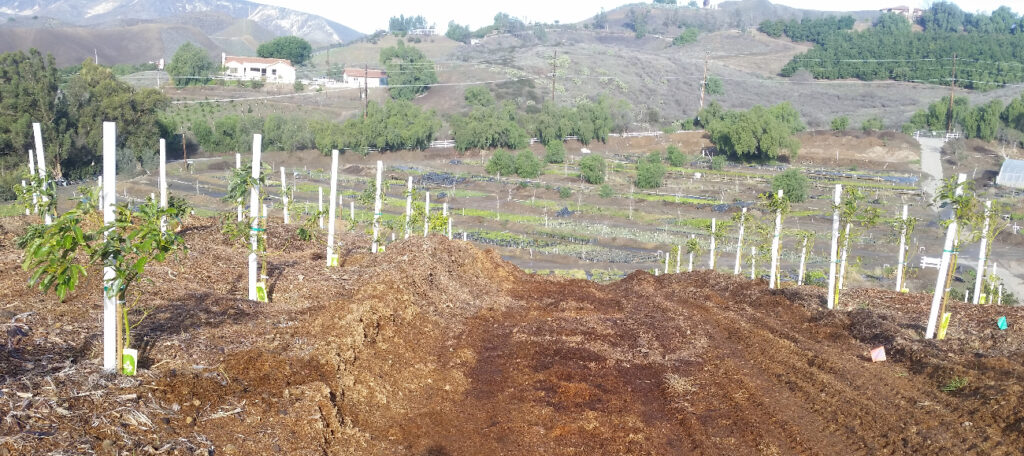
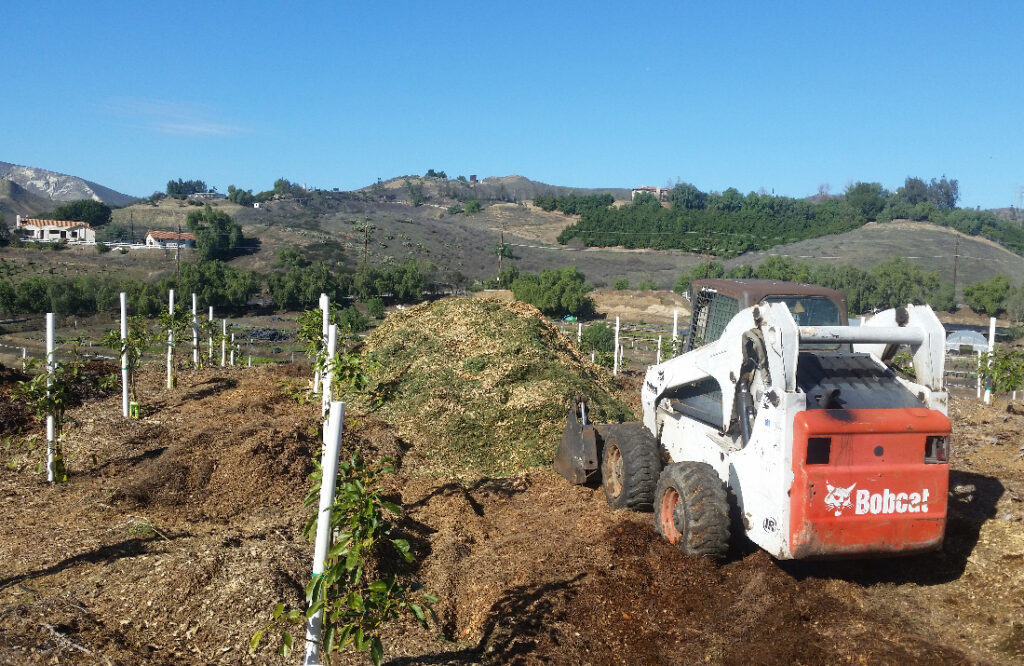

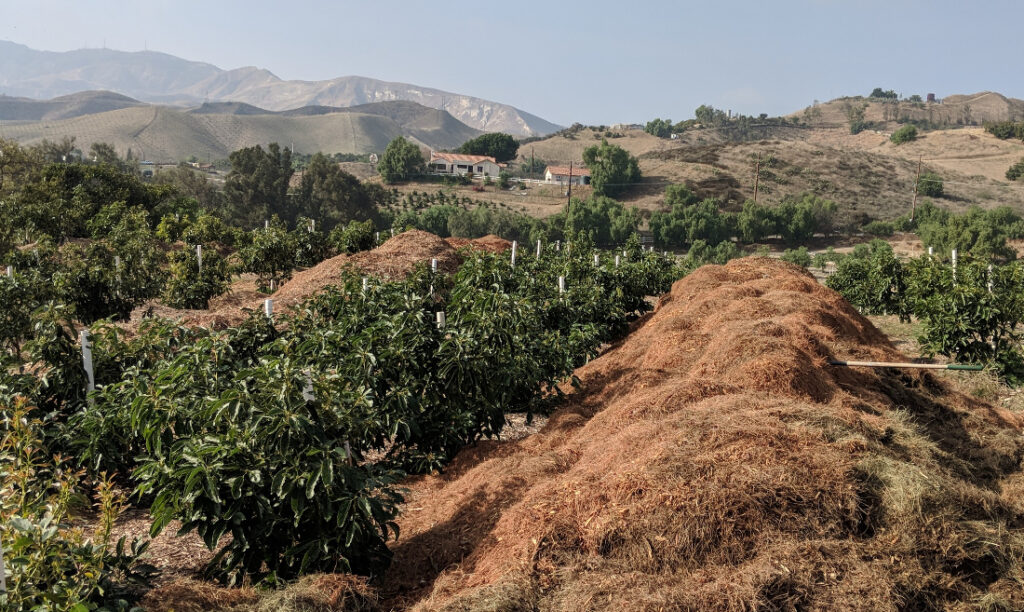

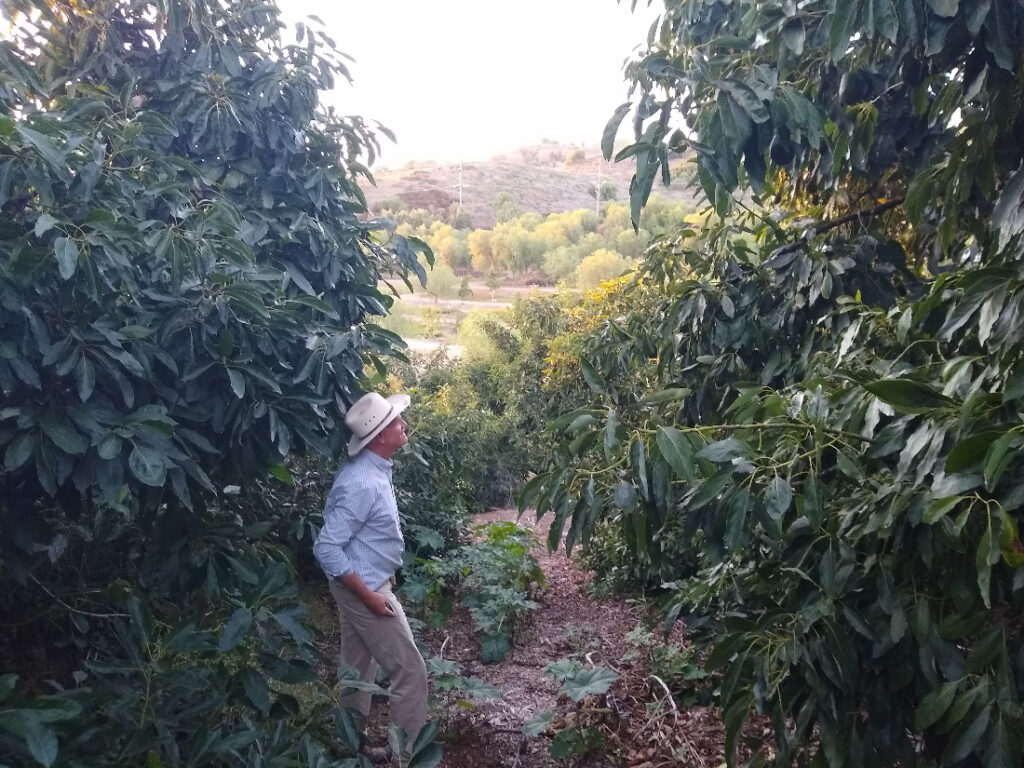
Do you also prune these younger Hass trees with the “teenager wood” concept in mind?
Yes, I choose major limbs on them to cut back within a couple feet of the “heart” of the tree within 4 years of planting. Hass is hard to manage with this spacing but Lamb and GEM are fine. I would rather have Hass planted 14 or 16 feet apart.
Can you talk about your newest plantings and what you’ve learned from them?
I wanted to prove or disprove my concept of growing avocados organically on ground with root rot so I next chose the area with the worst old trees, high on the hill to the east, windward side. I didn’t even want the advantage of clonal, resistant rootstocks. We built the berms and brought in the tree chips, and in May of 2019, we planted that area with Lamb on G6-seedling rootstock from Maddock Nursery.
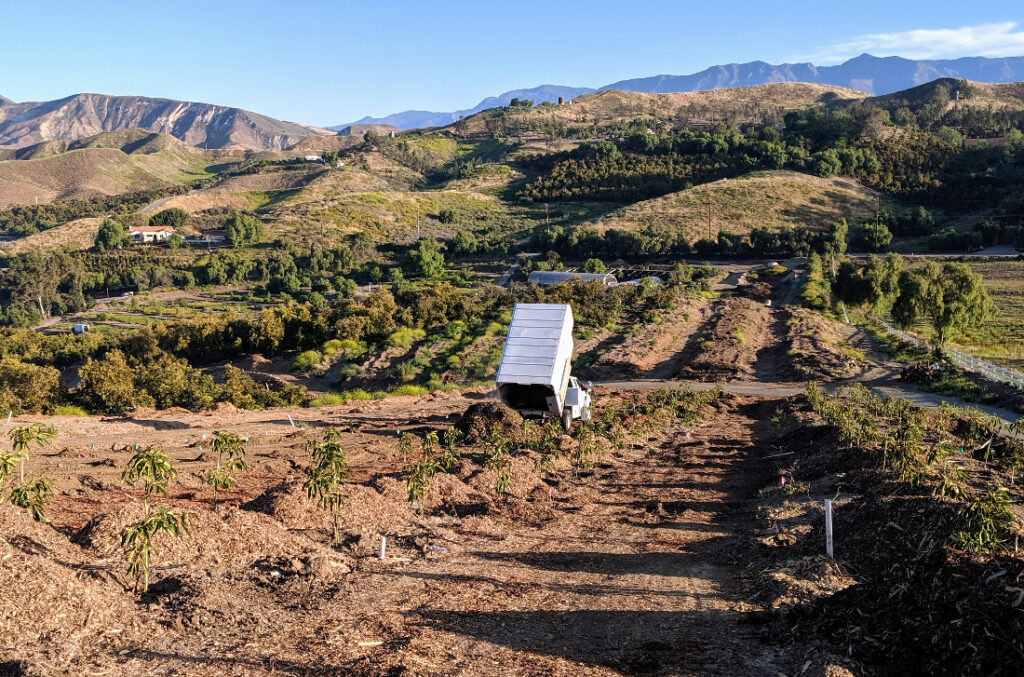
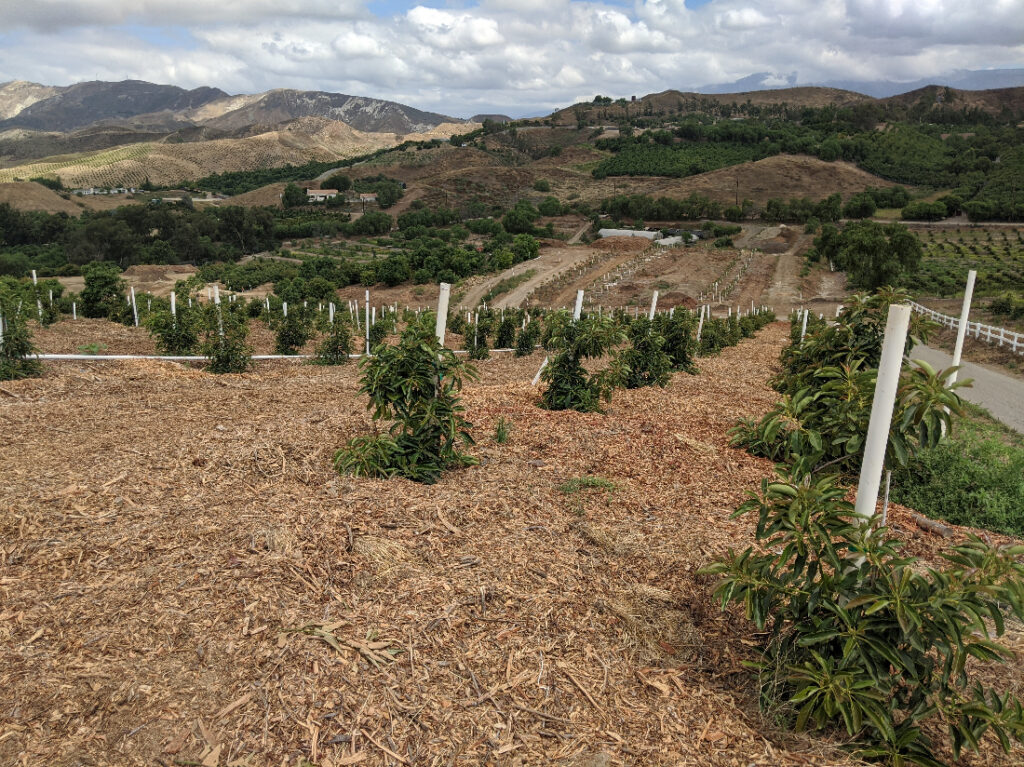
Last winter, the rainy winter of 2022-2023, was a good test. We ended up losing a few trees at the bottom of one berm that hadn’t been mixed well and had a layer of heavy clay. Being at the bottom of the hill, the soil stayed too wet, leading to low oxygen levels and root rot. Removal of some mulch and a bag of gypsum per tree seems to have saved a couple of those trees.
I’ve gotten better at building berms, ensuring a uniform mixture of the soil within the berm. I planted a second section of Lambs on better berms in the same area and now they’re about the same size as the 2019 planting.
(See the comment from John below the interview about the type of soil on his property and his method for building berms.)
So keys to your success at planting new trees in your conditions include berms for drainage and oxygen, and tree chips for organic matter that increase microbial suppression of P. cinnamomi. Anything else?
In addition to the mulch of tree chips, I grow cover crops but not in the conventional way. For avocado trees on a hill, instead of perennials, I want annuals that grow on rainfall alone. These are plants like Hairy Vetch, Sweet Clover, Telegraph Weed, Lupine and even mustard. Their function is also to increase soil life, but I don’t want to have to water them in the summer.
How do you knock them down and when?
I drive the tracked skidsteer over them and smash them flat with the bucket. There might be a few that need hand pulling in between trees, but the mulch makes that easy. I wait until the developing avocados are grape size in the spring so that they’re beyond being vulnerable to thrip damage (a common problem for organic growers.). The cover crops harbor beneficial insects that help reduce avocado thrip populations. We have very little thrip damage on our 2024 harvest even though it has been a bad thrip year for many.
What trends in the California avocado industry worry you?
Regulatory overload sucks the joy out of growing, especially FSMA [Food Safety Modernization Act of the U.S. Food and Drug Administration]. It treats avocados as if they were the same as lettuce. As it applies to avocados, FSMA is not based on science, is anti-environment, and is anti-small farmer.
Years ago, the California Avocado Commission did a wonderful job building demand for avocados, but today they’re unsuccessful at getting consumers to pay more for California avocados versus those from Mexico or Peru. CAC is funded by a marketing order [whereby California farmers are taxed on the avocados they sell] but hasn’t been able to get across the environmental benefits, improved shelf life and superior flavor of California-grown avocados. In stores it is difficult to even see whether an avocado is California grown.
Consumers are used to choosing between Good, Better and Best options. American Express cards, gas stations, and airlines all differentiate their offerings this way. To me, imported fruit is Coach, conventional California avocados are Business Class and Certified Organic California avocados are First Class. Pricing and promotion should reflect this.
The California Almond Board is doing a great job of going beyond vague platitudes to address environmental issues. I’d like for CAC to emulate their approach. I’d also like to see CAC support organic avocado farming research. Upcoming generations of consumers will seek out the California-grown organic option.
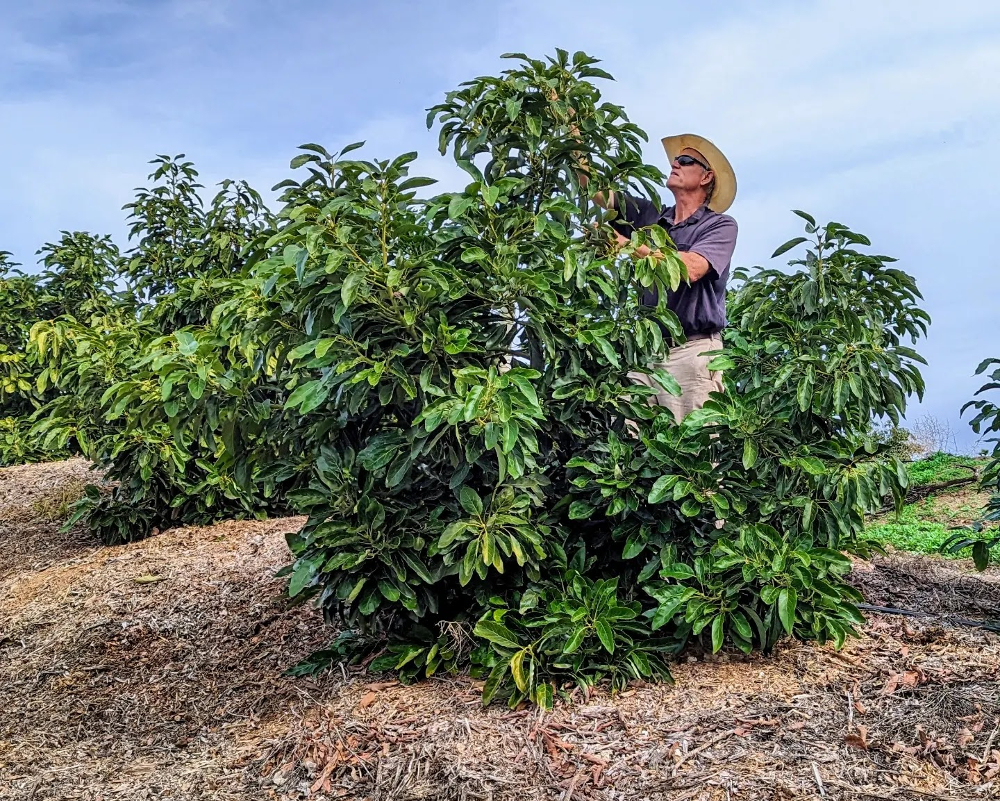
What gives you hope for the future of California avocados?
For me, there’s a market for late-season organic avocados. That’s why I’m planting more Lambs and Reeds. Big packinghouses [buyers of avocados from farmers] don’t want our avocados past about August because they want to be done with California fruit by then. A few smaller packers will take them and pay a premium. I’ve also seen that consumers and retailers will happily pay much more for high-quality organic avocados through the in-house marketing done at Apricot Lane.
I’m gratified by how much the younger generations value locally grown, sustainably produced crops, not just at home but in restaurants and other commercial settings.
It costs more to grow avocados in California. With better consumer experiences, proper marketing and improved handling we should be able get the premium price our avocados are worth.
(End of interview)
John’s practices and results in context
I fear that the significance of a few of John’s practices in his avocado grove will be overlooked if they aren’t understood in context. So let me briefly add three points.
One, that Schoustra hasn’t fertilized or sprayed his trees in fifteen years is unique among avocado farmers in California. I’ve never heard of anyone else growing in this way. And most importantly, Schoustra gets good crops from these trees that he does not fertilize or spray.
Two, that Schoustra applied less than one acre-foot of water last year is shocking. Most avocado growers in California apply three or four times that much. I believe Schoustra is able to irrigate so little primarily because of the deep mulch he has added. And again, most importantly, he is also getting good crops from his trees.
Three, it is commonly repeated among avocado farmers and advisors that you must use chemicals to fight root rot disease. In other words, you can’t be an organic grower if you have a root rot problem on your land. Schoustra is proving otherwise. He inherited old trees with root rot and has created new blocks of trees that are thriving even though he never added a chemical drop.
A short video of part of John’s grove
Also see my post about the fire that ripped through John Schoustra’s grove in the fall of 2024 here.
Thank you for your support so I can keep this website ad-free!
All of my Yard Posts are listed here

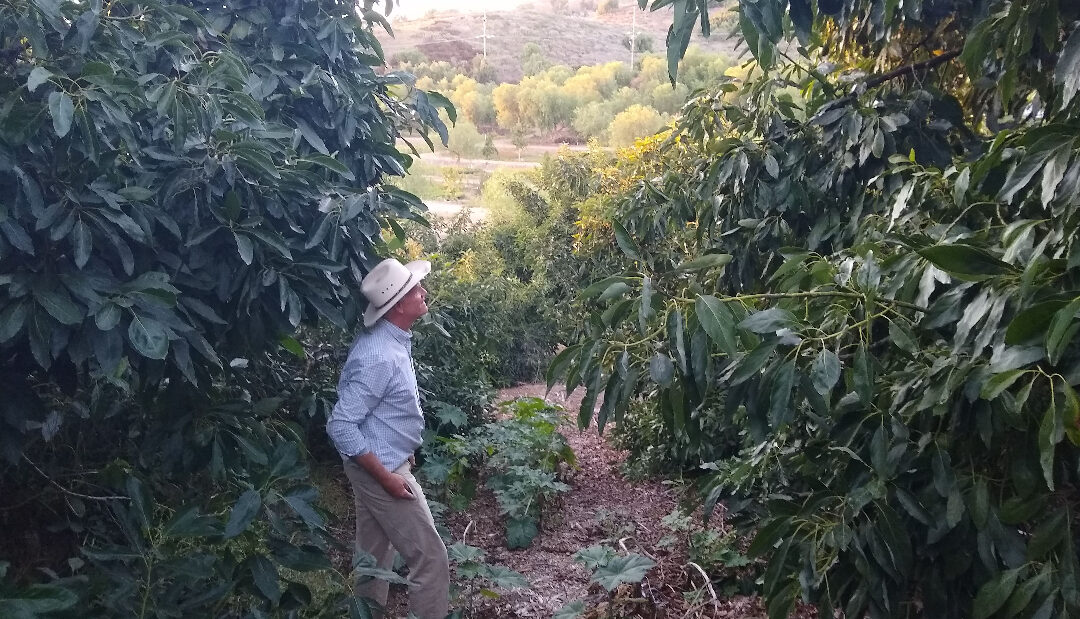


Fantastic interview! Also loved this quote describing P. cinnamomi as “a wimp of the rhizosphere.” Deep wood chips seem to create an “extra-soilular” environment for avocado roots and the organisms breaking down the cellulose.
Loved this interview, I’m going to try his pruning method on our 80 year old trees. Curious, with the deep mulch, what do his irrigation methods look like?
Hi Bryan,
I can attest that this pruning method of creating “teenager” wood works for me too.
For irrigation, John installs one 180-degree sprayer per tree at planting time, and then he adds a second 180-degree sprayer a couple years later.
Great information and validation!
I’m using my pine trees (Pinus pinea) pruning chips for mulching. No fertilizer at all.
My 3- and 4-years old trees look good so far, nice healthy deep green leaves and some avos (Hass; Bacon & Reed) growing well for the first time.
My idea is to replace the 90º sprayers by 360º micro sprinkler but not sure when to do this…
Thanks.
Awesome! Based on your posts, I quit fertilizing many years ago and only use wood chips. It cut my watering back a lot even during summer heat, I check regularly sticking my hand into the mulch and feeling the wet soil. I’m at year 7 of my avocado trees and hope this year is the year I greatly outpace the wildlife and have some for family and friends. I really hope the Avocado society upsells the whole California Organic Avocado, I would buy those all year at a higher price easily (Hopefully won’t have to in the future as I’m growing my own) as it is such a shame of all these imported avocados that are hit or miss with bruising and poor quality. Is there any way we can help support or push them as a consumer? On a hillside in Whittier
Hello Greg, can you please tell me where I can pick up mulch for my trees, growing organic. I’m in San Diego.
Thank You
Joe
https://gregalder.com/yardposts/where-to-get-wood-chips-for-mulch/
Thank you for this fantastic interview. Lots of great information for using wood chips as a mulch and why. The information on pruning older trees is also very interesting. As always your blogs are not only very informative but helpful as well.
Fantastic information as always! Very interesting and useful interview and post. Thank you so much Greg.
I grow with organic matter, compost and red wiggler worms in all of my 50 fruit trees and what happens over time is zero disease and bad insects. Now I know many of you do this with castings but including the worms, putting nature back where it belongs it will protect your trees. My education resources I always refer to is Cornell University where they have extensive information on this subject including the use of worms for medical waste, control of e-coli and listeria. My yard is diverse as well. I have been using worms since 1997. Adding them to any soil will give you the beneficials insects, fungus and bacterias needed to break down and improve your soil. https://cwmi.css.cornell.edu/vermicompost.htm#suppression. Worm are a must for disease resistant trees and plant.
Tinac, this sounds interesting with the Red wiggler works, I have lots of worms but no clue what type they are as they just pop up out of nowhere in my compost bins. Do you regularly add worms to your soil? If so, how often and how do you apply them, just dig a small hole and plop them in there under the trees? Thanks, James D On a Hillside in Whittier
Does the species of wood chip make any difference? Are avocado chips better? Schoustra has a ready supply of avocado wood for chipping, but I doubt that my four trees will ever supply enough, and really do not want a chipper around to use once a year. Is it even possible to buy avocado chips?
Good question John. My own avocado trees would only provide a fraction of the chips that I use, and I don’t have/don’t want a chipper. I have tree trimmers bring chips every day. There are apps for you to connect with tree services that need to dispose of tree chips. As long as you apply the chips to the surface of the soil, the tree species doesn’t matter.
Great article! Always so informative!!
So many questions 🙂 What kind of soil is he growing in? Are those berms local soil, or imported sandy loam? Does he plant in the wood chips, or allow the chips to pile up around the trunk and cover the root flare?
The original Hass Hill was a mess of sedimentary layers from dense black clay to almost beach sand. To correct this I applied 400 cubic yards of compost and a ton of gypsum to one acre, followed by ripping and cross ripping the soil. Then I built up the beds with the thoroughly mixed soil.
On the Lamb Hill I imported soil from foundation excavations. Sometimes the work got ahead of me and we ended up with pockets of clay. This caused problems later on.
Thank you so much for your reply and the information! Very inspiring and thank you for sharing your wealth of knowledge.
Great interview. Learned and confirmed a lot. As a back yard”farmer” i was using leaves from a huge liquid amber and fine wood chips from Tractor Supply on my trees. But the fine chips create something like a mat, so i switched to the larger chips(they come in a small bale) and they are working well. My Wurtz is 8 yrs and full. I placed wire fencing flat on the ground around it to keep the cats from making it their litter box. Now it’s dropping lots of old leaves and I scurry around picking up ones not under the tree, lift the wire fencing and sift all the leaves under so it keeps them from blowing away. In winter I cover its area with plastic sheeting, black side up to keep the 34 to 40 + inches of rain off. But if i build the mulch up some more, I might try going through winter without it. Thanks for your articles. Helps build my confidence.
Do commercial growers and/or small scale farmers incorporate b type trees into their groves for cross pollination?
Hi Paul,
Some do and some don’t.
John has been a good friend and colleague of mine for many years. He is a talented and experienced grower and his methodology has proven itself completely successful. His avocados are the best you will find anywhere. More of our commercial industry should pay close attention to John’s very successful program. I’ve been growing avocados, citrus, subtropical and deciduous fruit trees using similar methods for decades. Congratulations John for your successful cutting edge program. BTW, the produce from Apricot Lane Farms are also top shelf and deeeeeelicious.
Great interview. The fertilizer and water savings John has achieved is incredible. But I’m wondering: I have always heard that by adding woody mulch without a nitrogen source, the bacteria breaking down the wood will consume nitrogen in the process, leaving a deficit in nitrogen for the tree roots. Why does this problem not arise with John’s mulching?
Thanks!
The problem you refer to only occurs if you mix the mulch into the soil.
Thanks for your reply and congrats on your orchard!
I have a question about the best time to remove a limb from my avocado tree to promote the ‘teenage’ growth. When do you recommend that I do that?
Thanks!
Lisa in Santa Cruz